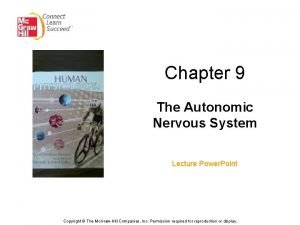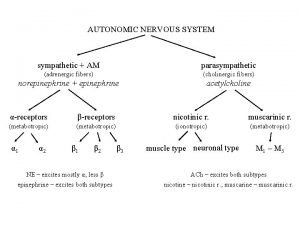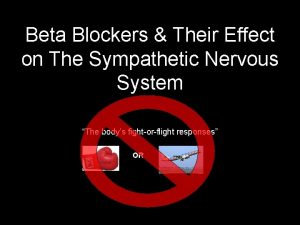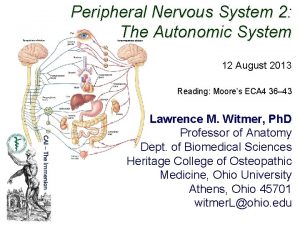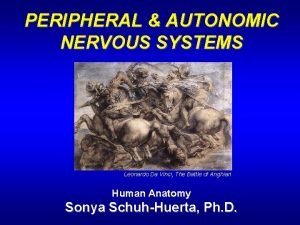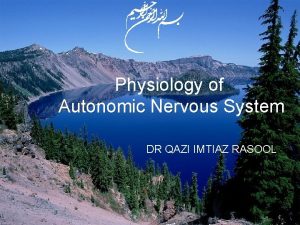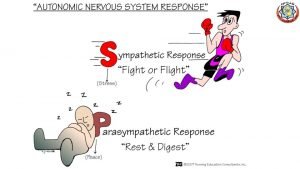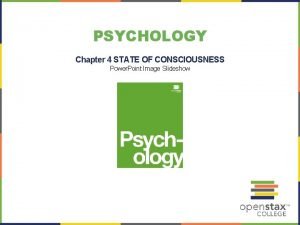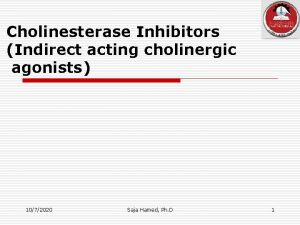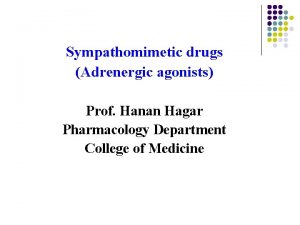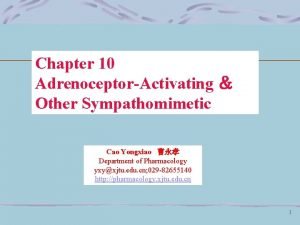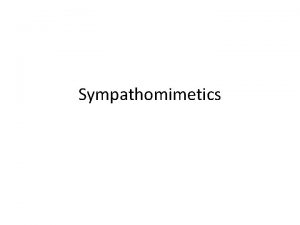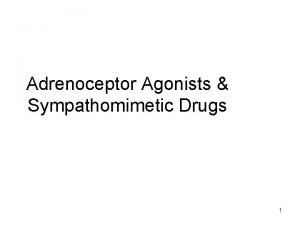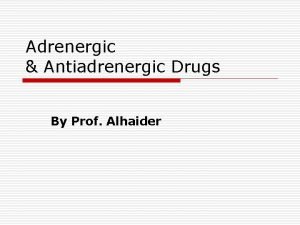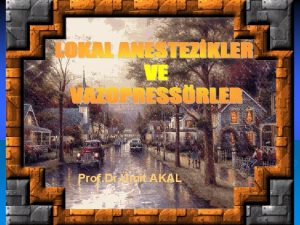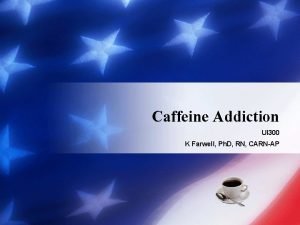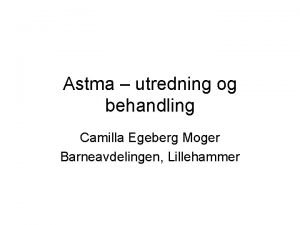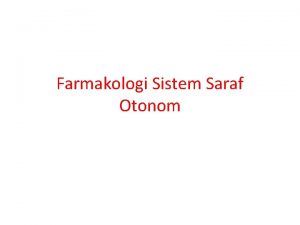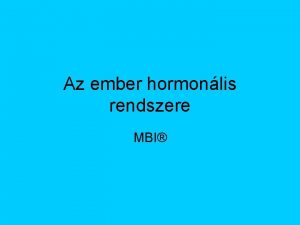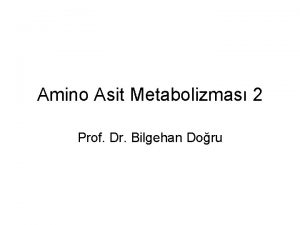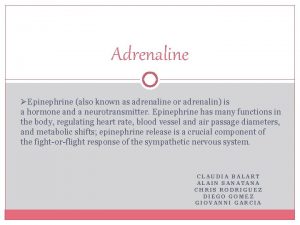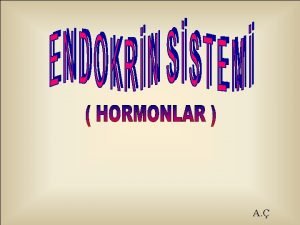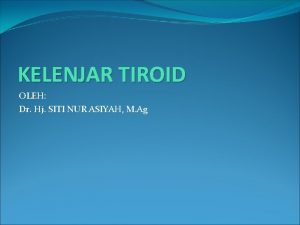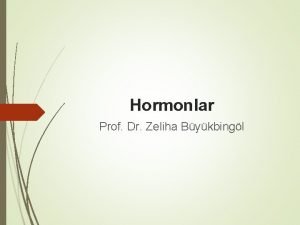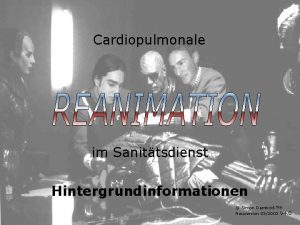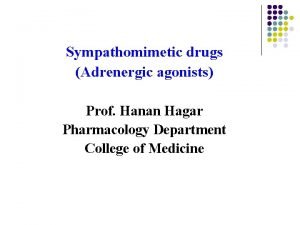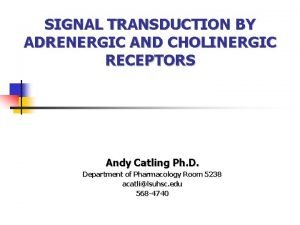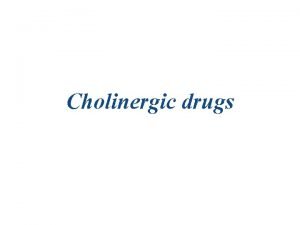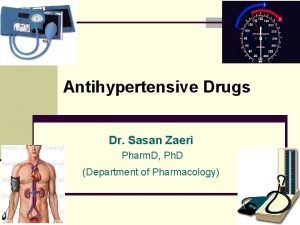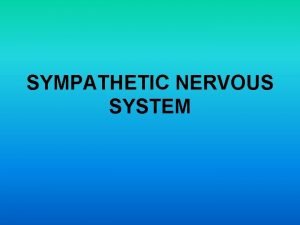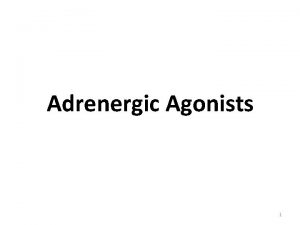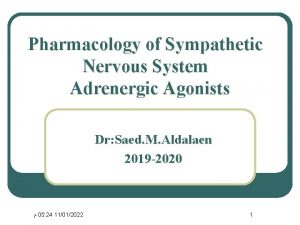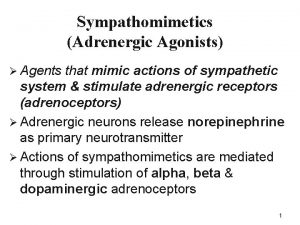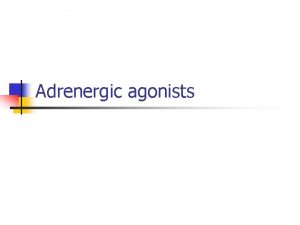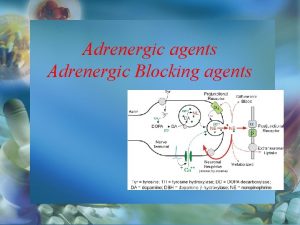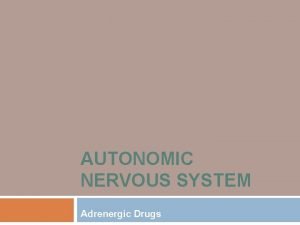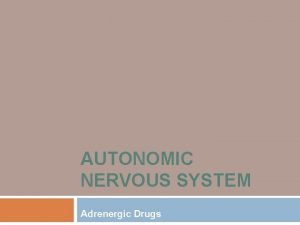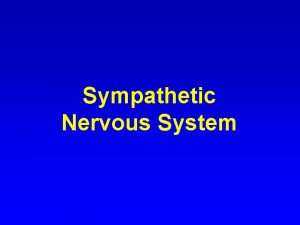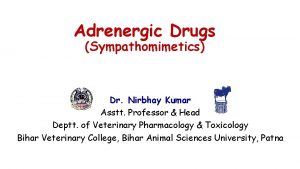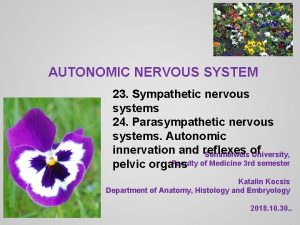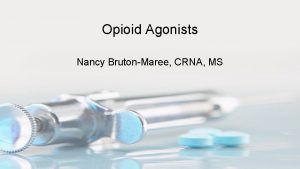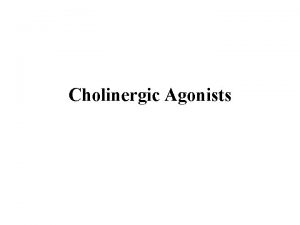Adrenergic Agonists Sympathetic Nervous System Adrenalin Noradrenalin Sympathomimetics




































- Slides: 36

Adrenergic Agonists

Sympathetic Nervous System ➢Adrenalin, Noradrenalin ➢Sympathomimetics (direct & indirect) ➢Sympatholytics ➢Adrenergic Receptors


Removal of Norepinephrine • Diffuse out of the synaptic cleft • Metabolized by COMT • Reuptake into the neuron ➢Tricyclic antidepressants (TCA, imipramine) ➢Serotonin-NE reuptake inhibitors (duloxetine) ➢Cocaine ➢Fate of NE /taken up by vesicles/amine transporter system ➢Release ➢Protected pools ➢Oxidized by MAO

Adrenergic Receptors

α-receptors Epinephrine ≥ NE >> isoproterenol α 1 Receptors ➢postsynaptic ➢Constriction of SM ➢Gptn-coupled Rs (phospholipase C) α 2 Receptors inhibitory autoreceptos ➢ inhibitory heterreceptors ➢Inhibition of adenylyl cyclase ➢ Subdivisions α 1 A, α 1 B, α 1 C, α 1 D-----Tamsulosin α 2 A, α 2 B, α 2 C

β-adrenergic Receptors • Isoproterenol > epinephrine > NE • Β 1, β 2, β 3 : • Β 1 epinephrine = NE • Β 2: epinephrine >> NE • Activation of adenylyl cyclase • Sk. M vasculature β 2 >> β 1 • Myocardium β 1 >>>> β 2 • Responses of adrenergic Rs


Desensitization of Receptors • Sequestration of Rs • Down-regulation • Inability to couple G ptn

Adrenergic Agonists A-Catecholamine B-Non-catecholamine C-Mixed-acting agonist


Epinephrine • Direct acting • Naturally occurring neurotransmitter • Adrenal medulla (80% Epi, 20% NE) • α & β • At low dose β (vasodilation) • At high doses α (vasoconstriction)

Epinephrine- CVS • +ve inotropic (β 1) • +ve chronotropic (β 1) • CO is increased • Oxygen demand is increased • β 1 in Kidneys---renin release---angiotensin II---? ? ? • α in arterioles in skin---? ? ? • β 2 vessels going to liver & Sk. Ms---? ? ? • Renal BF is decreased • Cumulative effect is increased sys BP & slight decrease in dias. BP


Epinephrine- cont. • Respiratory ✓Bronchodilation β 2 ✓Inhibit release of allergy mediators e. g. histamine from mast cells • Liver ✓Hyperglycemia due to increased glycogenolysis ? ? ? ✓Increased glucagon release ? ? ? ✓Decreased insulin release ? ? ? • Adipose tissues ✓Increased lipolysis ? ? ? ✓Increased c. AMP --- hormone sensitive lipase ---hydrolyze TG to FFA & glycerol

Therapeutic Uses of Epinephrine • Bronchospasm • Drug of choice in acute asthma & anaphylactic shock • Selective β 2 agonists are preferred in chronic asthma (albuterol) • Anaphylactic shocks • Cardiac arrest • Anesthetics (1: 100 000)

Pharmacokinetics • Rapid onset, short duration • IM, IV, SC, inhalation, endotracheal intubation • MAO, COMT---metanephrine, VMA Adverse effects • CNS (anxiety, fear, tension, headache & tremor • Cardiac arrhythmias • Pulmonary edema • CVS / hyperthyroidismm • Inhalation / tachycardia • Increase endogenous glucoses--- diabetes • Non-selective β-blockers? ? ?

Norepinephrine ✓CVS • Increase peripheral resistance • Increase syst. & diast. BP • Weak β 2 activity • Baroreceptor reflex (chronotropic effect) • Atropine + NE ? ? ? ✓Therapeutic uses ----- shock ✓Kinetics: IV, short duration of action, metabolized by COMT & MAO, excreted in urine ✓Adverse effects: blanching & sloughing of skin, T necrosis (extravasation)


Isoproterenol • Direct acting, synthetic • Stimulates both β 1 & β 2, nonselective • Insignificant α effects • + ve chronotropic & inotropic effect, increase HR & CO • Decrease PR ? ? • Syst. P increased ? ? ? • Diast. P decreased ? ? , Mean Arterial P? ? ? • Bronchodilator ? ? ? • Used in AV block


Dopamine • Metabolic precursor to NE • CNS (basal ganglia) and adrenal medulla • High dose ----vasoconstriction • Low doses ----- cardiac stimulation (+ve inotropic & chronotropic) • D 1 D 2 Rs (peripheral mesenteric & renal vascular bed)---? ? ? • Presynaptic D 2 Rs -----? ? ?

Dopamine, cont • Therapeutic uses: D of choice in cardiogenic & septic shock (contin. infusion) & superior to NE? ? ? • Used for hypotension & severe HF • Adverse effects: • Sympathetic stimulation • Rapid metabolism with COMT, MAO • Nausea, hypertension & arrhythmia

Fenoldopam • Agonist for peripheral D 1 • Used in severe hypertension (coronary arteries, kid. Arterioles, mesenteric arteries) • R isomer is active • Extensive 1 st pass effect (te 1/2=10 min after IV infusion) • Headache, flushing, dizziness, vomiting & tachycardia

Dobutamine • Synthetic, direct acting catecholamine, direct β 1 effect • Increases HR & CO without effect on O 2 demand • Used with caution in atrial fibrillation ? ? ? • Tolerance may develop

Oxymetazoline • Direct acting, synthetic cpd • Act on α 1 & α 2 • In OTC as nasal spray & ophthalmic drops • Systemic absorption, ———headache, nervousness & trouble sleeping • Rebound congestion

Phenylephrine • Synthetic, direct Acting, mainly α 1 • Increases both syst. & diast. BP • Reflex bradycardia • Decongestant (topically or orally) • It replaced pseudoephedrine • Induces mydriasis

Clonidine • α 2 agonist used in hypertension • Used to reduce opiates, tobacco and & benzodiazepine withdrawal symptoms? ? ? • Centrally, presynaptic--- • Side effects: lethargy, sedation, constipation & xerostomia • Avoid abrupt withdrawal? ?

Albuterol & Terbutalin • Short acting β 2 agonists • bronchodilation, / metered dose inhaler • Acute asthma-----albuterol • Terbutaline used as off labeled----uterine relaxation • Side effects: tremor, restlessness, apprehension & anxiety, (tachycardia, arrhythmia after oral admin. ) • MAOIs are cntraindicated? ? ?

Salmeterol & formoterol • LABAs / β 2 agonist • Single dose ----- sustained bronchodilation (12 hrs) • Salmeterol, delayed onset of action • Recommended for combination therapy (+ corticosteroids, e. g. flutecazone, budesonide) • Nocturnal asthma • LABAS showed increased risk of asthma-related deaths

Merabegron • β 3 agonist • Relaxes detrusor SM & increases bladder capacity • Used in overactive bladder • Increases BP • Increase level of digoxin • Inhibits CYP 2 D 6———— D-D interaction e. g. Metoprolol

Indirect Acting Adrenergic Agonists ✓Amphetamine • Centrally acting • α 1 & β 1 • Increase nonvesicular release of catecholamines ✓Tyramine • No therapeutic use • Oxidized by MAO • MAOIs ? ? ? • Mechanism ? ? ?

Indirect Acting Adrenergic Agonists, cont. ✓Cocaine • Unique local anesthetic • Block (Na+/ Cl-)- dependent transporter • Enhanced sympathetic activity • Prolong duration of action of Epi & NE

Mixed-Action Adrenergic Agonists ✓Ephedrine & Pseudoephedrine • Direct & indirect • Not a catecholamines, COMT & MAO ? ? ? • Absorption, distribution & elimination • Syst. & diast. BP • Bronchodilation • CNS stimulation, FDA? ? ? • Pseudoephedrine treat nasal & sinus congestion • Pseudoephedrine & methamphetamine


 Terminal ganglia
Terminal ganglia Cholinergic vs adrenergic
Cholinergic vs adrenergic Visceral autonomic nervous system
Visceral autonomic nervous system Beta-blockers for overactive sympathetic nervous system
Beta-blockers for overactive sympathetic nervous system Sympathetic parasympathetic
Sympathetic parasympathetic Sympathetic and parasympathetic nervous system difference
Sympathetic and parasympathetic nervous system difference Sympathetic tone definition
Sympathetic tone definition Module 10 the nervous and endocrine systems
Module 10 the nervous and endocrine systems Sympathetic nervous systems
Sympathetic nervous systems Divisions of the nervous system
Divisions of the nervous system Neuronal pool
Neuronal pool Nervous
Nervous Processes of a neuron
Processes of a neuron Ambenomium
Ambenomium Dopamine agonists
Dopamine agonists Indirect acting cholinergic drugs
Indirect acting cholinergic drugs Sympathomimetic agents
Sympathomimetic agents Sympathomimetic
Sympathomimetic Scopalmine
Scopalmine Sympathomimetics
Sympathomimetics Sympathomimetic effects
Sympathomimetic effects Fellypressin
Fellypressin Dependencies adrenalin ui
Dependencies adrenalin ui Metningsfall
Metningsfall Welcome to adrenalin somany
Welcome to adrenalin somany Contoh obat parasimpatomimetik
Contoh obat parasimpatomimetik Adrenalin túltermelés
Adrenalin túltermelés Sistationin sentaz
Sistationin sentaz Adrenaline or adrenalin
Adrenaline or adrenalin Heyecanlanma hormonu
Heyecanlanma hormonu Tiroid
Tiroid Anti insüliner hormonlar
Anti insüliner hormonlar Unblutiger aderlass durchführung
Unblutiger aderlass durchführung Sympathomimetic
Sympathomimetic Cholinergic vs adrenergic
Cholinergic vs adrenergic Cholinergic drugs act on receptors normally stimulated by
Cholinergic drugs act on receptors normally stimulated by Beta blockers mechanism of action
Beta blockers mechanism of action
